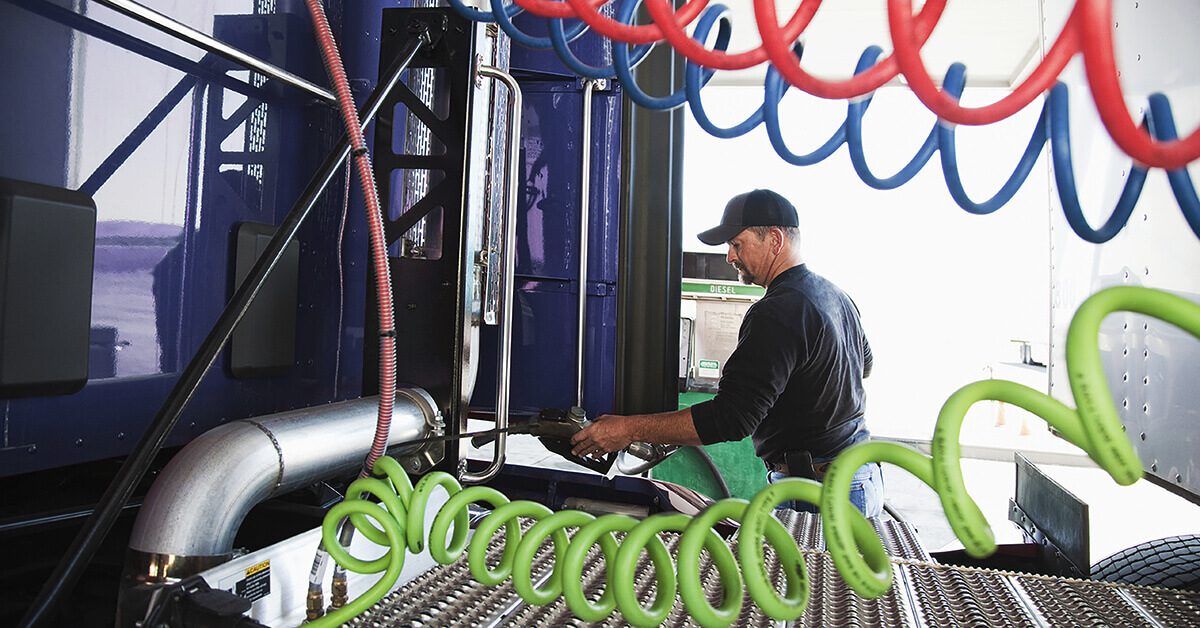The national average for diesel peaked at $5.25 per gallon in March 2022, nearly doubling since the start of 2021. The trucking industry is reeling from historically high fuel costs that could have major future implications.
To better understand the short- and long-term impact, DAT’s Chief Scientist Chris Caplice sat down with his colleague and carrier expert, DAT Principal Analyst Dean Croke, in “Dealing with Rising Fuel Prices,” the latest episode of Freightvine, a podcast by DAT iQ.

Fuel prices have created a dire situation right now, but it isn’t all doom and gloom. Their discussion reveals some items that could produce beneficial outcomes.
Threefold impact of high fuel costs
The variable cost of fuel is typically 20-25% of line-haul revenues for carriers. Currently, diesel is carving out 37%, on average. A dramatic spike in operating costs is especially difficult for smaller carriers unless they can somehow get a cash injection.
1. Higher fuel surcharges
Carriers do not recover the full cost of fuel increases, but those who know and understand their operating costs have a distinct advantage. They can accurately calculate the increased cost of doing business and build fuel surcharges into rates. Smaller carriers and owner operators who rely more on the spot market to find loads are not able to recoup as much or anything at all through fuel surcharges. With rising fuel costs, any leveling off – or worse, a drop – in line-haul rates is quite problematic.
“If I was doing a 1,000-mile trip, my gross line-haul revenue is down $315 since Russia invaded Ukraine and my fuel cost is up $180 over that same period, so it’s like a $500 swing,” Croke said. “I would need a 50-cent-per-mile fuel surcharge to even those two things out, which is more than what I am getting in the line haul market.”
2. Shrinking capacity
As carriers aim to reduce empty miles to conserve fuel, shippers with freight in rural locations or in areas with higher-than-average diesel fuel costs are going to see lower acceptance rates.
“Carriers are being much more selective about load (choice), being very careful about running too far from the next load, so they’re being more cognizant about pricing their loads into those markets to compensate for the repositioning of the assets to another load point,” Croke pointed out.
Additionally, some owner-operators are choosing to take a break and not haul loads for a few months, or they are being very discerning about which lanes or how many miles they want to run, Croke noted.
While some owner-operators can simply park their truck and wait it out, others cannot. However, the cost of running their own truck is too high, so many are likely to go back to driving for a large fleet.
3. Pricing power is shifting
Shippers have reported that rates are normalizing and their load acceptance rates are going up. This could be explained by the impacts of the war in Ukraine on the freight market. Retail numbers went down 3.5% in March, dampening demand and people are not traveling as much or spending as much on services.
With high fuel costs, “normalized” rates are dissolving carriers’ profit margins.
“Spot rates are still up 4 cents a mile, about where they were this time last year, so we’re not in danger territory, but they have slid 32 cents a mile in the last month,” Croke noted. … “The worst-case scenario is that a year ago, I was making 55 cents per mile [in profit]; today, I’m making 13 cents gross profit. So in one month, I had a 77% drop in my gross profit margin. … Fuel is causing a lot of pain as a small fleet operator; it’s gone from 49 cents per mile in operating costs to 80 cents with my fuel surcharge this week being 62.5 cents, so even with the fuel surcharge, I’m still not getting full cost recovery.”
Where do we go from here?
Even though fuel prices will come down, it could take time. The scaled release of the strategic oil reserves could help, but the ongoing invasion in Ukraine is creating turbulence in the energy and freight markets
“Capacity has loosened rapidly over the past six week and rates have dropped 30 cents per mile in the last month,” Croke stated.
But that’s not all he expects to see.
“We’ll see capacity bleed off pretty quickly,” Croke said. “It’ll be the same as 2019 – the last ones in will be the first ones out.”
The industry sector bearing the greatest burden of fuel prices is new-to-the-market owner-operators who purchased used trucks at record-high prices. They will have to auction their trucks. Some will go back to truckload carriers and others will leave the industry entirely.
In the long term, Croke expects lessons to be learned from the volatility of the market over the last couple of years as well as the impact of the high fuel costs.
“We’re much smarter now,” Croke notes. “Carriers have realized it’s costing a lot more to run their trucks. It’s not just diesel. … I’m paying a lot more for tires; my insurance costs are up. Everything has gone up.”
Fleets are also paying drivers more to retain them. While fuel costs will eventually even out, driver wages and other costs will remain high and must be taken into consideration when predicting rates.
For the full conversation, including more insights on how today’s market compares to years past, listen to this DAT Freightvine podcast.


